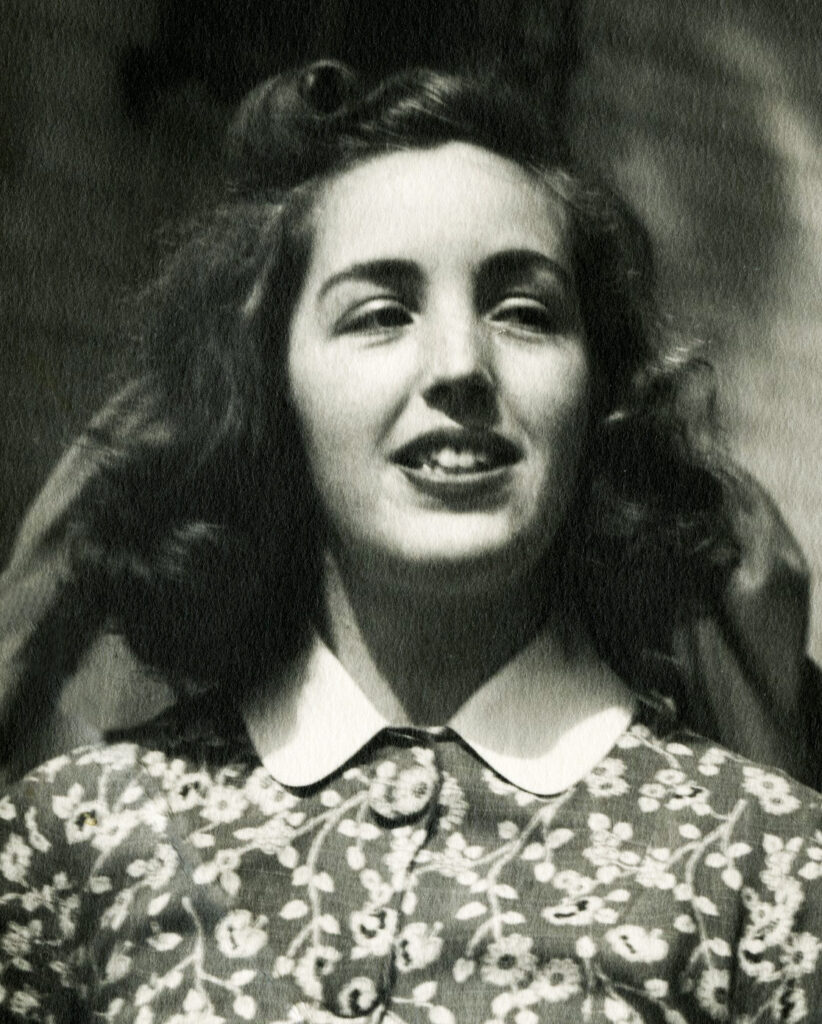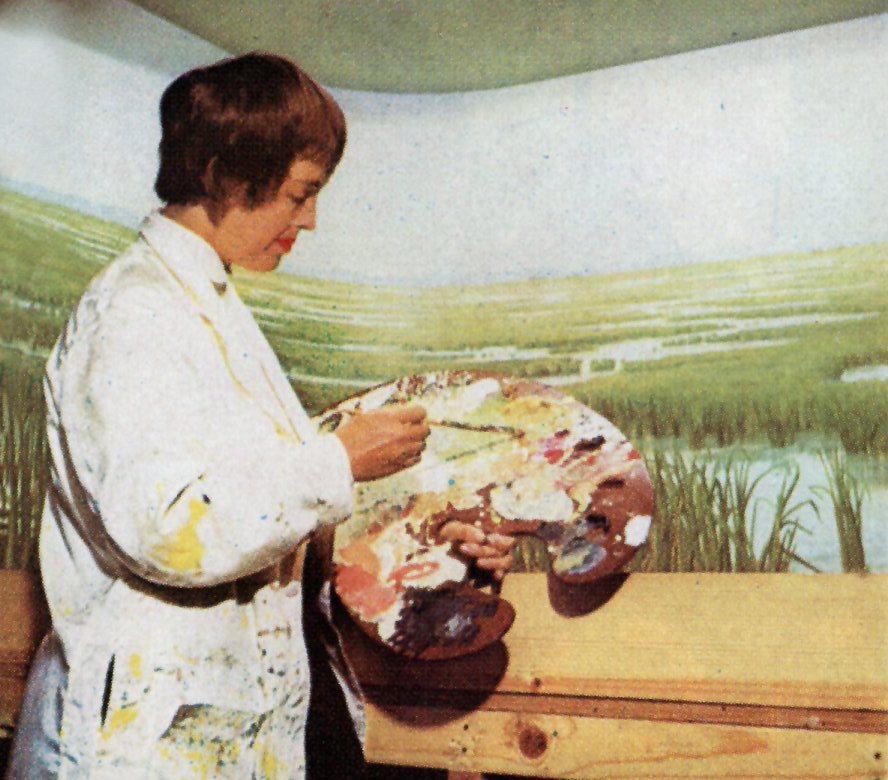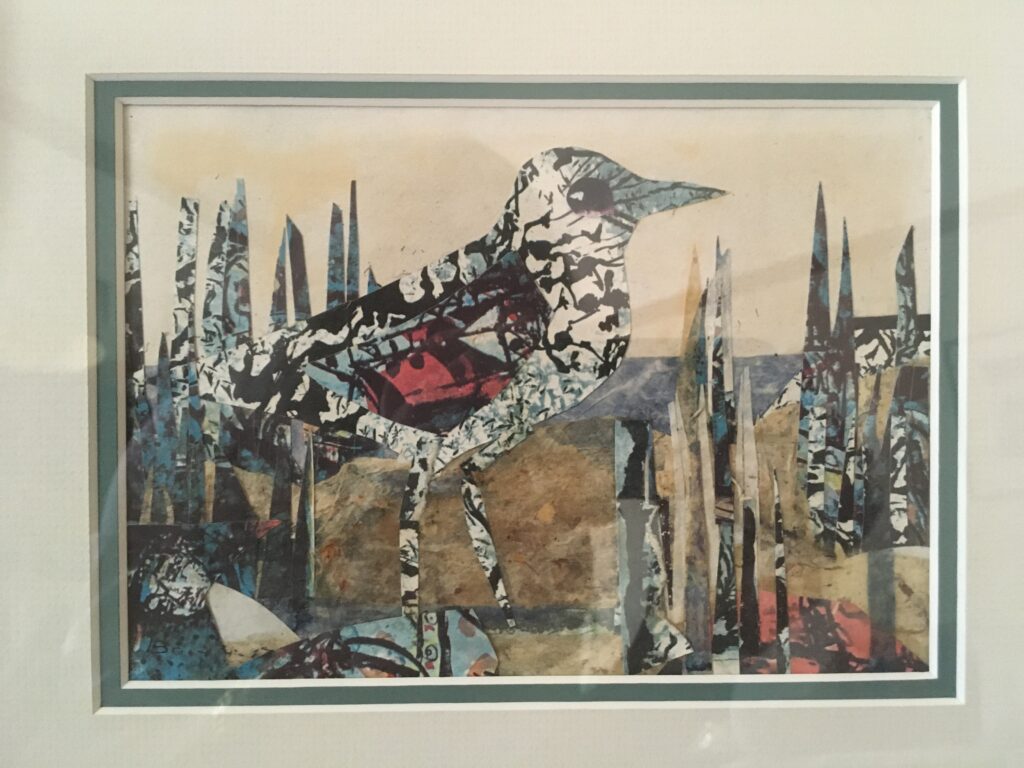The information below has been compiled from a variety of sources. If the reader has access to information that can be documented and that will correct or add to this woman’s biographical information, please contact the Nevada Women’s History Project.

At A Glance:
Born: April 26, 1916 in Carson City
Died: January 9, 2005 in Carson City
Maiden Name: Bordewich
Race/nationality/ethnic background: Caucasian
Married: Donald L. Bowers, July 21, 1956
Primary city and county of residence and work: Carson City
Major Fields of work: artist, librarian, museum illustrator
Other role identities: Sierra Club chapter co-founder, member
Biography
Carson City native created life of art, library work, friendships
Nancy Bordewich Bowers lived in a world of art, books, the beauty of the outdoors, and family love and friendship. In some ways, she lived in worlds she created for herself, but she also lived in the real world where she was a dedicated artist, a librarian, a friend and a sister.
Born Carolyn Nancy Bordewich, in the house where her mother was born in Carson City, she was known for the rest of her life as “Nance” or “Nancy.” She was born six years after her sister Grace, an acclaimed Carson City teacher, in whose shadow she played a supporting role.
Her father, Arthur H. Bordewich, descended from Norwegian seafaring families, worked as head foreman of the pressroom of the Nevada state printing office for 40 years. Nancy always had lots of drawing paper, she remembered, because her father would bring home uneven cuts of paper from the press.
Nancy’s mother, Agnes Bertha Cutts, was born in Carson City. Nancy’s grandfather, Augustus Cutts, came west from Maine as a government scout and was superintendent of refining mills on the Carson River near Empire. In her oral history published in February 2000, Nancy said, “The Cutts family goes back to 1620. Three well-to-do brothers came from England seeking adventure and they came to Kittery Point, Maine, and one of them was named by the King of England as the first Governor of New Hampshire. They made ships and were very prominent in American history. One was with George Washington at Valley Forge, they were in Congress. I feel this kind of staunch patriotism.”
Nancy quoted a newspaper story about Augustus’ visit to his home in Maine and meeting his future wife, Jennie Libby, swinging on the garden gate. “She left this wonderful atmosphere to live at the bottom of Devil’s Slide on the Carson River where she had this constant din of sound from the mills. They had so little room for building along this cut in the river that they built this house out over the river with pilings. When the timber would float down river for the mines, it kept banging (against the house).” Augustus and Jeanette Cutts settled in Carson City in the 1870s.
Nancy said she had an “enchanted childhood” with a very happy family. Their house “was a wonderful house with very high ceilings and twelve layers of wallpaper.” A trunkful of 1880 garments, old maps and prints in an old building in back of her house fostered her imagination. “I really lived in a Victorian past and partly still do.” Family friend Tina Nappe wrote, “I always felt they (Nancy and her sister Grace) represented the high society of the Victorian Age.”
The family lived a block away from the Abe Cohn family and their ward, the renowned Washoe basketmaker Dat So La Lee. “I was fascinated by Dat-so-la-lee and once I peeked in the window where Dat-so-la-lee was weaving, making her baskets. She was a huge woman with the most delicate hands.”
At Abe Cohn’s shop, The Emporium, Nancy would sit in the lap of an employee named Mr. Riley. “I was a child who had a sort of make-believe language and he tried to make me say words the way they should be said.”
“One of the joys I had at the age four, I had a library card at the state library.” Nancy remembered roller skating through the Capitol to go to the library which was in the octagonal building behind the Capitol. “I loved it when my father would call and say he’d forgotten his glasses. There was no traffic then and you could just skate anyplace and I skated down to the printers’ office. It had a wonderful fragrance of printer’s ink.”
Nancy and Grace were educated in Carson City in a schoolhouse that served all grades from first through high school. “The first six grades were on the first floor and the seventh through high school were on the second. To show you the size of the school, I think there were seventeen in my graduating class.”
Her artistic ambitions surfaced early. Nancy said she “always wanted to be a second Sarah Bernhardt or I wanted to be a great dancer. I tap danced and I did monologues and (acted) in plays.”
Nancy Bordewich Bowers attended the University of Nevada in Reno for two years followed by two years at the University of California at Berkeley, majoring in art and English. She continued her education for two years at the California School of Fine Arts in San Francisco.
“When I went to Berkeley, I lived at the International House, which had 400 students from all over the world. It was a wonderful, broadening experience for me.”
During World War II, Nancy worked two years as a technical illustrator at Consolidated Vultee Aircraft that was building B-24 bombers in San Diego and, on the referral of her trainer, lived in the Mission Cliffs home of Dr. Clinton G. Abbott, head of the natural history museum for the San Diego Zoo. “I lived a weird, topsy turvy life. I lived in a real mansion for a couple of years and drew blueprints and crawled inside the wings of bombers.”
Next, a friend in San Diego tipped her off about a job in San Francisco, and she became secretary to the Chief of the Overseas Branch of the Burmese Division Office of War. After that job, she worked five years, 1946-1951, as secretary to the director of the San Francisco Museum of Art, and started painting, winning prizes and participating in shows with other women artists.
When she returned to Carson City, she was employed at the Nevada State Museum from 1951 to 1956, painting dioramas and installing exhibits. Her helper was teenage Mike Shawnessey, who worked in the woodshop and is now a volunteer tour guide at the museum.

“I painted the blue skies of the dioramas and then she did all the artwork,” Shawnessey said. “I helped build the trees and she would do the fine work. She would put in a chipmunk or a squirrel. When she got an idea, it had to be the way she wanted it,” Shawnessey said. “She was easy-going but off in her own world, her own thoughts, being an artist in a different way.”
Under the leadership of Judge Clark J. Guild, Nancy was involved with the creation of the Mobile Museum, a 35-foot trailer specially fitted with exhibit cases and painted blue and silver. It was launched into service at the Washoe County Fair in summer 1954. The Mobile Museum was retired at the end of the 1968 school year after more than 50,000 miles on Nevada roads and visited by more than 450,000 schoolchildren and adults.
In 1956, she married Donald L. Bowers, longtime editor of Nevada Magazine. Their marriage ended in divorce after about 10 years.

She was first and foremost an artist, said longtime friend and columnist Guy W. Farmer. She produced many prizewinning paintings, specializing in miniatures in her later career. She was one of 10 outstanding artists featured at the Nevada Art Gallery in Reno in June 1958. Among her many awards: Merit First Award from the Brewery Arts Center for “Meadow” on Oct. 28, 1986; Second place prize from the Miniature Art Society of New Jersey for “Primitive” on April 7, 1991; and first place in collage from the Miniature Sculptors, Painters and Gravers Society of Washington, D.C, on Nov. 14, 1993. She won awards in the San Francisco Art Association’s exhibitions; in Nevada Artists Association shows; St. Mary’s Art Shows in Virginia City; the Nevada State Fair; The National League of American Pen Women state arts shows; first prize in the Carson City Centennial Art Show for her rendering of the historic Bliss Mansion, and the Auburn, Calif., Arts Festival. She was a member of the National League of American Pen Women.
Another lifelong love was books. “My association with the State Library started at the age of four, when I obtained my first library card. It opened a world of wonder and enchantment to me and awakened a love of books that affected my entire life.” She worked at the Nevada State Library for more than 30 years in the interlibrary loans section. She retired on Sept. 26, 1984 and received a congratulatory letter from Governor Richard Bryan.
Nancy and Grace had a great love of nature, and spent many happy hours hiking with journalist Guy W. Farmer and his wife Consuelo, and photographer Gus and Jeanne Bundy and their two daughters, Molly and Tina. The Bordewich sisters helped to establish the Toiyabe Chapter of the Sierra Club.
Tina Bundy Nappe remembers going to Dardanelles Lake and American Flats as well as dining with the sisters at home. “They were excellent cooks and equally amazing conversationalists.”
Nancy Bordewich Bowers created many close friendships, further enriching her life and the lives of others. She accompanied her sister Grace to many social activities and ceremonies honoring Grace. She lived with and cared for Grace in her later years.
The Bordewich sisters played a key, positive role for the Farmer family. Guy W. Farmer described them as “mentors” for his Mexican-born wife, Consuelo, while she studied U.S. history and the Constitution before taking her citizenship exam. “They took Consuelo in under their loving, protective wings,” Farmer said, and they were the two official witnesses when Federal Judge Bruce Thompson swore Consuelo in as an American citizen in mid-1967.
“Everybody loved Nancy,” Farmer said. “She was happy, nice, sweet to everybody. She danced to her own music.”
Researched and written by Janice Hoke
